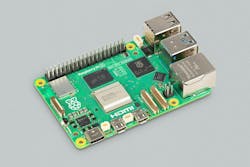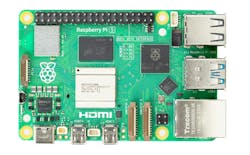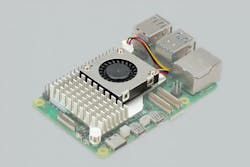Round 5: A Cool Raspberry Pi
This article is part of the TechXchange: Raspberry Pi.
What you’ll learn:
- What’s new in the Raspberry Pi 5?
- Challenges that arise when using the Raspberry Pi 5.
I finally got my hands on the Raspberry Pi 5 from Newark, based on a 2.4-GHz Broadcom BCM2712 system-on-chip (SoC), and it packs a punch (Fig. 1). The platform is ideal for rapid prototyping and has a massive development community.
The SoC contains a quad-core 64-bit Arm Cortex-A76 CPU with cryptography extensions along with a VideoCore VII GPU that supports OpenGL ES 3.1 and Vulkan 1.2, unlike the earlier 1.8-GHz quad Cortex-A72. The module has the standard 40-pin header along with the Power-over-Ethernet (PoE) header. Equipped with either 4 or 8 GB of LPDDR4X-4267 memory, it supports more than half a dozen operating systems, including Linux variants and Windows 11.
Managing Heat: Challenges Using the Raspberry Pi 5
Like its predecessor, the Raspberry Pi 5 can get a little toasty when running full tilt. Luckily there is a plethora of cooling options from fans to hefty heat sinks (Fig. 2). I’ve been running it without a heatsink, but performance is limited by the available cooling capabilities of the system.
Another potential limiting factor is the power supply. The optimum is a USB-C with Power Delivery (PD) support for 5 V/5 A. Only a few power supplies offer this option, which is needed if you want to boot from a USB drive. There are two USB 3.0 ports that support 5 Gb/s, as well as two USB 2.0 ports. The main non-volatile memory option is the microSD socket that supports the 104-MB/s UHS-I SDR104 mode. The other option is to use the x1 PCIe 2.0 interface via an M.2 HAT or similar adapter.
Connectivity is first-class with dual-band 802.11ac Wi-Fi, Bluetooth 5.0 and Bluetooth Low Energy (BLE), and Gigabit Ethernet. The latter supports PoE+ via a PoE+ HAT that’s compatible with the Raspberry Pi 4.
On the video side, a pair of 4Kp60 microHDMI outputs feature HDR support. I had to buy a pair of adapters to be able to connect using a standard HDMI cable. On the hardware side, there’s a built-in 4Kp60 HEVC decoder and two 4-lane MIPI camera/display transceivers, providing more throughput than before.
The Raspberry Pi 5 is a bit pricier than the earlier version, starting at $60 with 4 GB of RAM. Overall, the extra cost is well worth the added functionality and performance. Developers do need to consider how thermal performance will affect their application.
Getting up and running is easier with the Raspberry Pi Imager software that operates on Windows, Mac, and Linux. Just select your device, OS, and target storage device, and wait for the download to complete. I would have been up and running almost immediately except I had to get the HDMI adapter cables.
The Raspberry Pi community is one of the largest open-source environments. A comparable Raspberry Pi Compute Module will be available in the future. The CM4 is the latest version, which matches the Raspberry Pi 4. The Compute Module has found homes in a variety of industrial and commercial applications.
Read more articles in the TechXchange: Raspberry Pi.
About the Author
William G. Wong
Senior Content Director - Electronic Design and Microwaves & RF
I am Editor of Electronic Design focusing on embedded, software, and systems. As Senior Content Director, I also manage Microwaves & RF and I work with a great team of editors to provide engineers, programmers, developers and technical managers with interesting and useful articles and videos on a regular basis. Check out our free newsletters to see the latest content.
You can send press releases for new products for possible coverage on the website. I am also interested in receiving contributed articles for publishing on our website. Use our template and send to me along with a signed release form.
Check out my blog, AltEmbedded on Electronic Design, as well as his latest articles on this site that are listed below.
You can visit my social media via these links:
- AltEmbedded on Electronic Design
- Bill Wong on Facebook
- @AltEmbedded on Twitter
- Bill Wong on LinkedIn
I earned a Bachelor of Electrical Engineering at the Georgia Institute of Technology and a Masters in Computer Science from Rutgers University. I still do a bit of programming using everything from C and C++ to Rust and Ada/SPARK. I do a bit of PHP programming for Drupal websites. I have posted a few Drupal modules.
I still get a hand on software and electronic hardware. Some of this can be found on our Kit Close-Up video series. You can also see me on many of our TechXchange Talk videos. I am interested in a range of projects from robotics to artificial intelligence.



